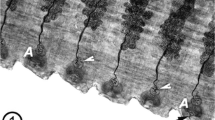Summary
The female accessory glands include the tubular poison gland, the paired, lemon-shaped uterus glands, and Dufour's gland, an unbranched tubular organ. They consist essentially of a single layer of epithelium cells surrounded by a basement membrane. The lumen is lined by cuticle. The proteinaceous secretion of the poison gland is released into intracellular ducts provided with microvilli, each connected to a channel lined with cuticle which leads to the central lumen of the gland. The channel is formed by special canal cells. Nerve endings are interspersed among the gland cells. The uterus gland consists of four cell types derived from a single type of precursor cell found in newly hatched wasps. Type I cells are covered by type II cells and are thus without contact to the luminal surface of the gland. They contain stacks or whorls of mitochondria and smooth cisternae in an alternating arrangement. Vesicles with a secretory product are found in cells of types II and III. Deep anastomosing infoldings of the plasmalemma, stabilized by microtubules and dense material at the branchings, are characteristic for type II cells. Most secretory vesicles are found in type III cells, the prevalent cell type which is thought to be the source of the lipoprotein secretion. Coated vesicles are present at deep infoldings of the plasmalemma. The greatly enlarged apical surface area of type IV cells and the presence of mitochondria in slender outgrowths is suggestive of an osmoregulatory function. In Dufour's gland, two cell types appear in succession, the first with a very dense cytoplasm, the second with dense inclusions and many seemingly empty vesicles of smooth endoplasmic reticulum. The secretion products, lecithin and a cholesterol ester, are thought to be formed by the second cell type. The dense inclusion might be lecithin, which reacts with osmium tetroxide. The cholesterol ester could have been washed out of the “empty” vesicles by the embedding procedure.
Similar content being viewed by others
References
Beaulaton JA (1968) Modifications ultrastructurales des cellules sécrétices de la glande prothoracique de vers à soie au course des deux derniers àges larvairs. J Cell Biol 39:501–525
Berridge MJ, Gupta BL (1968) Fine structural localization of adenosine triphosphatase in the rectum of Calliphora. J Cell Sci 3:17–32
Bogenschütz H (1975) Prüfung des Einflusses von Pflanzenschutzmitteln auf Nutzinsekten. Erarbeitung eines Laborverfahrens mit der Ichneumonide Coccygomimus turionellae. L. Z Angew Entomol 77:438–444
El-Hifnawi E, Seifert G (1973) Die Speicheldrüsen der Diplopoden I. Topographie und Histologie der Speicheldrüsen von Polyxenus lagurus, Craspedosoma rawlinsii and Schizophyllum sabulosum. Z Morphol Tiere 74:323–348
Fine RE, Ockleford CD (1984) Supramolecular cytology of coated vesicles. In: Danielli JE (ed) Membranes. Academic Press, London New York (International reviews of cytology, vol 91)
Führer E (1973) Sekretion von Mucopolysacchariden im weiblichen Geschlechtsapparat von Pimpla turionellae L. (Hym.). Z Parasitenk 41:207–213
Günther J (1971) Entwicklungsfähigkeit, Geschlechtsverhältnisse und Fertilität von Pimpla turionellae L. nach Röntgenbestrahlung oder Abschnürung des Eihinterpols. Zool Jahrb Anat 88:1–46
Harlan WR, Wakil SI (1963) Synthesis of fatty acids in animal tissues: I. Incorporation of C14-acetyl coenzyme A into a variety of long chain fatty acids by subcellular particles. J Biol Chem 238:3216–3223
Kilincer N (1975) Untersuchungen über die hämocytäre Abwehrreaktion der Puppe von Galleria melonella L. (Lepidoptera) und über ihre Hemmung durch den Puppenparasiten Pimpla turionellae L. (Hym., Ichn.). Z Angew Entomol 78:340–370
Munn EA (1974) The structure of mitochondria. Academic Press, London New York
Osman SE (1978a) Die Wirkung der Sekrete der weiblichen Genitalanhangsdrüsen von Pimpla turionellae L. (Hym.) auf die Hämocyten und die Einkapselungsreaktion von Wirtspuppen. Z Parasitenk 57:89–100
Osman SE (1978b) Der Einfluß der Imaginalernährung und der Begattung auf die Sekretproduktion der weiblichen Genitalanhangsdrüsen und auf die Eireifung von Pimpla turionellae L. (Hym., Ichneumonidae). Z Angew Entomol 85:113–122
Osman SE, Führer E (1979) Histochemical analysis of accessory gland secretions in female Pimpla turionellae L. (Hym.). Int J Invertebr Reprod 1:323–332
Rabes I (1935) Untersuchungen über die weiblichen Geschlechtsorgane von Apanteles, mit besonderer Berücksichtigung der akzessorischen Kerne. Z Zellforsch Mikrosk Anat 23:701–736
Ratcliffe NA, King PE (1969) Ultrastructural changes in the mitochondria of the acid gland of Nasonia vitripennis (Walke) (Pteromalidae: Hymenoptera). Z Zellforsch 99:459–468
Schlüter U (1980) Plasmalemma-mitochondrial complexes involved in water transport in the hindgut of a milliped, Scaphiostreptus sp. Cell Tissue Res 205:333–336
Sreng L (1979) Ultrastructure et chimie de la secretion des glands tergales du male de Blatella germanica (L.) (Dictyoptera: Blatellidae). Int J Insect Morphol Embryol 8:213–227
Staddon BW (1979) The scent glands of Heteroptera. Adv Insect Physiol 14:351–418
Stein G (1966) Über den Feinbau der Duftdrüsen von Feuerwanzen (Pyrrhocoris apterus L., Geocorisae). Z Zellforsch 74:271–290
Stein G (1969) Über den Feinbau der Duftdrüsen von Heteropteren. Die hintere larale Abdominaldrüse der Baumwollwanze Dysdercus intermedius Dist. (Insecta, Heteroptera). Z Morphol 65:374–391
Wessing A, Eichelberg D (1969) Elektronenmikroskopische Untersuchungen zur Lipidspeicherung in den Nervenzellen von Drosophila melanogaster. Z Zellforsch 94:129–146
Wessing A, Eichelberg D (1973) Elektronenmikroskopische Untersuchungen zur Struktur und Funktion der Rektalpapillen von Drosophila melanogaster. Z Zellforsch 136:415–432
Author information
Authors and Affiliations
Rights and permissions
About this article
Cite this article
Blass, S., Ruthmann, A. Fine structure of the accessory glands of the female genital tract of the ichneumonid Pimpla turionellae (Insecta, Hymenoptera). Zoomorphology 108, 367–377 (1989). https://doi.org/10.1007/BF00312277
Received:
Issue Date:
DOI: https://doi.org/10.1007/BF00312277




